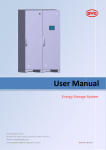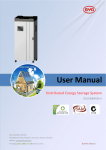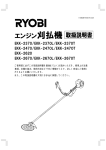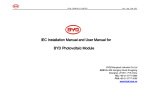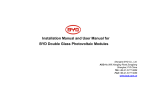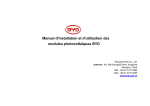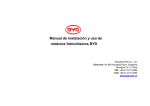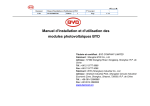Download BYD Photovoltaic Module Installation Manual
Transcript
BYD Photovoltaic Module Installation Manual BYD (Shanghai) Industrial Co.. Ltd Address: No.999 Xiangjing Road, Songjiang, Shanghai, 201611, P. R. China TEL: +86-21-5777 8888 FAX: +86-21-5777 5086 Website: www.byd.com.cn, http://www.bydenergy.com CONTENTS Foreword................................................................................................................................................. 3 1. Transportation and storage manual............................................................................................ 4 2. Installation ......................................................................................................................................... 4 2.1 Warning .................................................................................................................................... 4 2.2 Mounting holes introduction............................................................................................... 6 2.3 Mechanical installation......................................................................................................... 6 2.3.1 Warning ................................................................................................................................. 6 2.3.2 Way of installation.............................................................................................................. 7 2.4 Electric installation.............................................................................................................. 11 3. Maintenance and Care .................................................................................................................. 13 3.1 Maintenance of the PV module(s).................................................................................... 13 3.1.1 Keep the surface clean.................................................................................................... 13 3.1.2 Machine and electricity examination ........................................................................... 14 3.1.3 Setting site maintenance ................................................................................................ 14 3.2 Maintenance of supporting equipments ........................................................................ 15 4.Claim................................................................................................................................................ 15 Appendix Ⅰ......................................................................................................................................... 16 Appendix Ⅱ......................................................................................................................................... 18 2 Edition No. BYD-21June-2011 Foreword This manual includes the transportation, installation and maintenance of PV modules (hereafter referred to as “module”). Please read this manual carefully before installing and using the modules. Please get in touch with provider if you have any questions. The part of transportation introduces the notice proceeding. Please read this part carefully if users need storage;Installation manual includes warning, mechanical and electric installation. Mechanical installation introduces three kinds of methods, using mounting holes,clamps and insertion system to install. Users can choose appropriate installation fashion according to kinds of places. Before installing a solar photovoltaic system, installers should familiarize themselves with it’s mechanical and electrical requirements. Please protect modules periodically after installation. Please read the third part about maintenance. Our company provide the mounting holes, drain holes and grounding holes. These holes have pass the safety testing. Installers can’t drill and block drain holes random. This manual is the same with all the normal modules of BYD Company Limited. Keep this guide in a safe place for future reference (care and maintenance) and in case of sale or disposal of the modules. 3 Edition No. BYD-21June-2011 1. Transportation and storage manual Please observe the follow criterion after packing. (1) Don’t lean ≥15° when transit packing boxes (2) Box up according to the sign of packing box. (3) Be careful of transit, and don’t strike violently. (4) The packing boxes should be protected for rain. (5) Transportation condition: -40℃~+85℃ 2. Installation 2.1 Warning (1) Do not use mirrors or other magnifiers to artificially concentrate sunlight on the modules. (2) Do not touch live terminals with bare hands. Use insulated tools for electrical (3) Although modules are quite rugged, the glass can be broken (and the module will no longer work properly) if it is dropped or hit by tools or other objects. (4) Under normal conditions, a photovoltaic module is likely to experience conditions that produce more current and/or voltage than reported at standard test conditions. Accordingly, the value of Isc and Voc marked on this module should be multiplied by of 1.25 when determining component voltage ratings, conductor current ratings, fuse sizes, and size of controls connected to the PV output. (5) The installation work of the PV array can only be done under the protection of sun-sheltering covers or sunshades and only qualified person can install or perform maintenance work on this module. 4 Edition No. BYD-21June-2011 (6) One single module may generate more than 30V DC when exposed to direct sunlight. If modules are in series, voltage is equal to every module’s voltage. If modules are in parallel, current is equal to every module’s current. If the installers have many modules in series or in parallel, please don’t touch by hand without any insulated measures. (7) Systems should be installed by qualified personnel only and at least two persons. The system involves electricity, and can be dangerous if the personnel are not familiar with the appropriate safety procedures. (8) Please read and understand the manual carefully before installation, connection, operation and maintenance. (9) Follow the battery manufacture’s recommendations if batteries are used with modules. Please observe the native rule and law when installing modules. You must obtain the architecture license. (10) Please unpack carefully. (11) The installation work of the PV array can only be done under the protection of sun-sheltering covers or sunshades and only qualified person can install or perform maintenance work on this module. (12) For roof application, the PV system must be mounted, over fire resistant roof covering rated for the application. Caution: Please unpack in appropriate environment, and use special tool. The modules should be waterproof and damp proof. 5 Edition No. BYD-21June-2011 2.2 Mounting holes introduction Model measure P6-18 P6-24 P6-27 P6-30 P6-36 L 1482 1325 1482 1640 1956 W 676 992 992 992 992 T 50/40 50/40 50/40 50/40 50/40 A 626 942 942 942 942 B 802 476 500 860 800 C / 1076 1100 1360 1300 2.3 Mechanical installation 2.3.1 Warning (1) Optical check before installation, to make sure there is no bug in the packing 6 Edition No. BYD-21June-2011 and junction box as well as the surface of module. (2) The users should design and build metallic bracket for installing and bearing the weight of the PV modules. The brackets are specially designed for users’ installation places such as the open land or on the roof of houses. (3) In most applications, PV modules should be installed in a location where they will receive maximum sunlight throughout the year. In the Northern Hemisphere, the modules should typically face south, and in the Southern Hemisphere, the modules should typically face north. When choosing a site, avoid trees, buildings or obstructions, which could cast shadows on the solar. When choosing clamping or insertion system, according to PV’s specification choosing appropriate bracket, bracket should occur corrosion. (4) Put the solar cell modules on the frame and put on the screws and then combine them firmly after put on all the washers. All the screw caps should be finished on the frame together firmly. The module frame is made of anodized aluminium, and therefore corrosion can occur if the module is subject to a salt-water environment with contact to a rack of another type of metal. (Electrolysis Corrosion) if required. Stainless steel washers can be placed between the solar module frame and support structure to prevent this corrosion. (5) Don't envelop the drain holes with other components when install modules. Junction box should at the top of the module. (6) Don’t grasp the junction box or cable when install modules. (7) PV array shouldn’t the minimum 5in/ft (127mm/305 mm) when modules are installed in rooftop. (8)Installing modules should use every mounting hole, the number of mounting holes as the follow chart: Model measure n P6-18 P6-24 P6-27 P6-30 P6-36 4 8 8 7 Edition No. BYD-21June-2011 8 8 2.3.2 way of installation (1) Bolting Use mounting holes to fix up as the follow figure. Users must tighten screws with the fastening torque. For a 5400Pa load,using eight mounting holes (2) Clamping Modules could use the clamps as the follow picture, the clamps must have enough intensity to fix up modules (recommending using stainless steel), and their structure couldn’t shelter the cells. Module installed with clamps on a long short frame, “B’” is the clamping range: 8 Edition No. BYD-21June-2011 For a 5400Pa load,use four clamps on a long frame module measure P6-18 P6-24 P6-27 P6-30 P6-36 120 110 120 140 150 250 250 250 300 300 A (distance form module edge to clamping range) B (clamping range) Installation method: Installation detail: Installation clamping methods on a short frame as below: 9 Edition No. BYD-21June-2011 For a 2400Pa load, using four clamps on a short frame Installation method: Installation detail: 10 Edition No. BYD-21June-2011 (3) Insertion system Modules could use insertion system as the follow picture to install, .and the insertion system must have enough intensity to fix up modules, such as stainless steel and other appropriate metal to support PV module: For a 2400Pa load, using an insertion system on a short frame 2.4 Electric installation (1) Way of grounding: All module frames should be grounded for safety. (2) All module frames should be grounded for safety. The grounding connections 11 Edition No. BYD-21June-2011 between modules must be approved by a qualified electrician, the grounding itself must be made by a qualified electrician. The ground wire should be at least the same size as the electrical conductors, ground wires no less than 12AWG are recommended(recommending torque value:1.5N.M). The modules should be connected in series or parallel with the modes as below. (3)Simple serial -connection of modules (4)Simple parallel- connection of modules (5) The bypass diode have a Rated Average Forward Current 10A ,and a Rated Repetitive Peak Reverse Voltage 50V. (6) Our connectors have 05-1, 05-6 and MC4,when users connect PV modules with inverter, users had better use the same connectors’ inverter, if not or be not compatible, users could collocate switchover connector. (7) When designing the system, we recommend that the maximum number of modules in parallel and the maximum number of modules in series as below: Type The maximum number of modules in parallel The maximum number of modules in series BYD ***P6-18 No more than two No more than forty 12 Edition No. BYD-21June-2011 BYD ***P6-24 No more than two No more than thirty-five BYD ***P6-27 No more than two No more than thirty BYD ***P6-30 No more than two No more than twenty-five BYD ***P6-36 No more than two No more than twenty 3. Maintenance and Care The PV module is the most important part for the solar photovoltaic energy system, which affects the dynamoelectric efficiency of the system and the using of the sunshine, so as the electric conversion. Sheltering the module(s) will affect the dynamoelectric efficiency greatly. The outside-putting module(s) can be eroded. So the surface of the module(s) should be kept clean, and the bracket should be stabilized. 3.1 Maintenance of the PV module(s) 3.1.1 Keep the surface clean Clean the surface of the module(s) for periods. Check the glass to ensure the surface is good before cleaning. If it is broken, please do not clean and inform to the purchaser and maintenance. Do not wear the watch or jewellery when cleaning. Use the soft fabric clean out the dust. If the dust is hard to wipe out, use the water to clean. Then use the clean fabric wiping up the water carefully. Do not use hard tools or mordant solution wiping the module for avoiding leaving scrape so as to affect the light transmission efficiency. The power attenuation caused by the scrape is beyond our guarantee range. Do not wipe on the day, and you had better to clean on the night or morning without strong sunshine. Do not use the cold water to clean the module so 13 Edition No. BYD-21June-2011 as to avoiding broking the glass. According to the local climate, If there is bad weather like rainstorm, people must take measures to protect the module(s) from damage. 3.1.2 Machine and electricity examination (1) Check the module’s setting of machine on time. Check the support equipment (fastness, erosion, bolts and nuts, especially the place where the wind or shake is hard. Ensure the fixing is fast. If not fast, screw them down.) (2) Check the module’s electric line (connection to the equipment and earth) for a settled time. Check the grounded resistance satisfying the designation request. If the connection is not fast, jointing it. After the thunderstorm or before, check the junction box and other protectors for the thunder. If invalidation, replace it according to the request. (3) Check the lead connector for the leakage current and deal with it. Be care for the rainy or snowy weather which affects the leakage current. When checking the lead, People must take the insulated sets (such as tools and gloves). Don’t touch the uncovered lead or the connectors with uncovered hands. Check the connections of each part to ensure them fast every 6 months. If not, connect them. Wipe the dust up from the equipment regularly to keep it clean. (4) If the module needs repaired, cover with fabric or other material. Or it may produce high voltage under the sun. Notice: If the connection becomes less crowded, please inform to the professionals. 3.1.3 Setting site maintenance The site where the modules settled should not has too high trees or architectures. The modules must be sure without covere. 14 Edition No. BYD-21June-2011 3.2 Maintenance of supporting equipments (1) Avoiding eroded: If the condition permits, the metal fittings that fasten or support the modules should be protected from the eroded, such as the bolts and nuts. (2) Basic maintenance of support equipment: Set some essential safeguard to protect all the modules’ basic and peripheral equipments from erosion in the rain. Notice: If the system goes wrong, please let the professional engineers deal with it. Others should not disassemble the system optionally. 4.Claim As the adherence to this manual and the conditions or methods of installation, operation, use and maintenance of photovoltaic (PV) products are beyond BYD’s control. BYD does not accept responsibility and expressly disclaims liability for any loss, damage, or expense arising out of or in any way connected with such installation, operation, use or maintenance. The information in this manual is based on BYD’s knowledge and experience and is believed to be reliable; the manual provides reference, and consumer could choose appropriate installation according to place and environment. BYD reserves the right to change the manual, the PV produce, the specifications, or product information sheets without prior notice. 15 Edition No. BYD-21June-2011 Appendix Ⅰ Electrical Characteristics At STC for BYD 2BB Series: BYDP6-18 Type Pm *Vm *Im *VOC *ISC BYD120P6-18 120 17.50 6.86 21.00 7.61 BYD125P6-18 125 17.60 7.11 21.11 7.89 BYD130P6-18 130 17.80 7.30 21.24 8.15 BYD135P6-18 135 17.90 7.54 21.38 8.49 BYD140P6-18 140 18.00 7.78 21.49 8.76 BYD145P6-18 145 18.10 8.01 21.60 8.95 BYD150P6-18 150 18.68 8.03 23.35 8.98 Type Pm *Vm *Im *VOC *ISC BYD220P6-30 220 28.29 7.80 36.18 8.40 BYD225P6-30 225 28.49 7.91 36.36 8.44 BYD230P6-30 230 28.67 8.02 36.75 8.50 BYD235P6-30 235 29.06 8.09 37.07 8.69 BYD240P6-30 240 29.55 8.12 37.54 8.90 BYD245P6-30 245 30.06 8.15 37.80 8.94 BYD250P6-30 250 30.40 8.22 38.00 8.98 BYD255P6-30 255 30.99 8.23 38.70 8.99 Type Pm *Vm *Im *VOC *ISC BYD260P6-36 260 34.62 7.51 42.77 8.22 BYD 265P6-36 265 34.70 7.66 42.84 8.23 BYD270P6-36 270 34.80 7.76 43.03 8.34 BYD275P6-36 275 34.93 7.87 43.28 8.46 BYD280P6-36 280 35.23 7.95 43.93 8.57 BYD285P6-36 285 35.52 8.02 44.58 8.59 BYD290P6-36 290 35.76 8.10 44.82 8.82 BYDP6-30 BYDP6-36 16 Edition No. BYD-21June-2011 BYD295P6-36 295 36.00 8.19 45.00 8.90 BYD300P6-36 300 36.20 8.29 45.25 8.99 BYD305P6-36 305 36.75 8.30 45.94 9.01 17 Edition No. BYD-21June-2011 Appendix Ⅱ The other Characteristics of PV module: 1. Maximum system Voltage: 1000V 2. Application Class: Class A 3. PV module Structure dimension: BYDP6-18: 1482×676×50; BYDP6-30: 1640×992×50; BYDP6-36: 1956×992×50; 4. Maximum fuse current rating: 15A 5. Specifications Cell: Polycrystalline silicon Front glass: 3.2mm tempered glass Frame: Anodized aluminium alloy Junction box: IP65 rated Number of bypass-diodes : BYD P6-36, BYD P6-30:6/3 BYD P6-18:4/2 Cables: 4mm2 /12AWG Connector: MC4/05-1/6-1394461-2 and 1394462-4, IP67 Remark: the above ele appropriate ctrical characters are only for reference. 18 Edition No. BYD-21June-2011


















